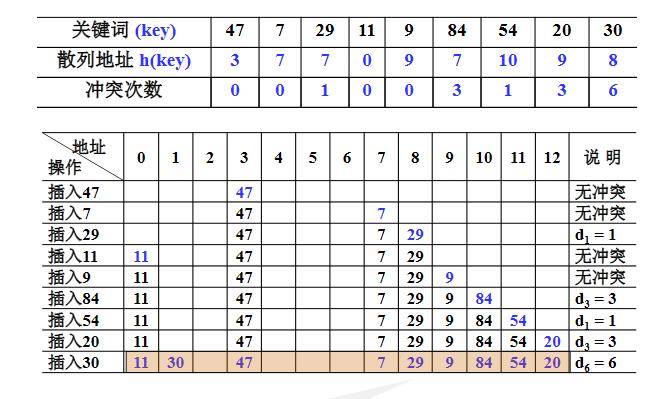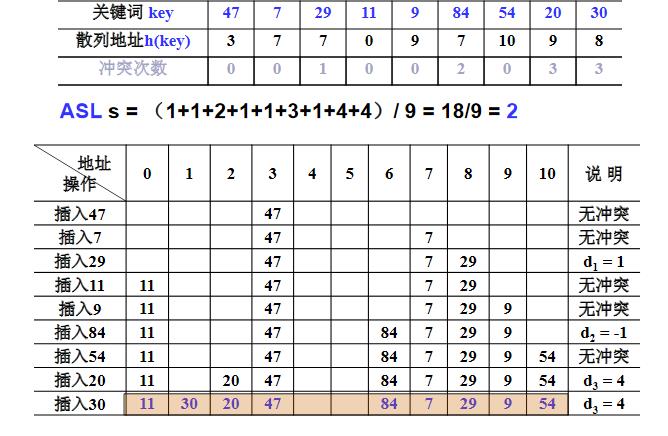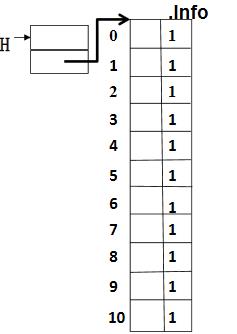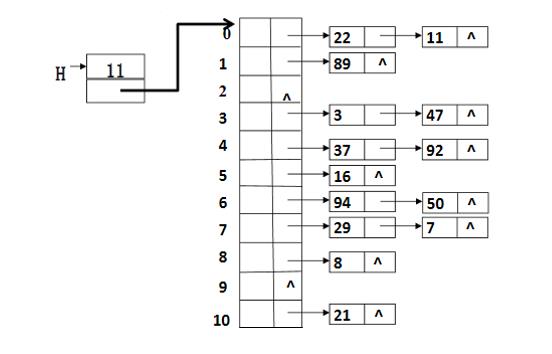数据结构—— 散列查找:冲突处理方法
Posted 大彤小忆
tags:
篇首语:本文由小常识网(cha138.com)小编为大家整理,主要介绍了数据结构—— 散列查找:冲突处理方法相关的知识,希望对你有一定的参考价值。
数据结构系列内容的学习目录 → \\rightarrow →浙大版数据结构学习系列内容汇总。
3. 冲突处理方法
3.1 处理冲突的方法
常用处理冲突的思路:
⋄
\\diamond
⋄ 换个位置:开放地址法
⋄
\\diamond
⋄ 同一位置的冲突对象组织在一起:链地址法
3.2 开放定址法
★
\\bigstar
★ 开放定址法(Open Addressing)
一旦产生了冲突(该地址已有其它元素),就按某种规则去寻找另一空地址;
若发生了第i次冲突,试探的下一个地址将增加d,基本公式是:
h
i
(
k
e
y
)
=
(
h
(
k
e
y
)
+
d
i
)
h_{i}(key)=(h(key)+d_{i})
hi(key)=(h(key)+di) mod TableSize( 1
≤
\\leq
≤ i
<
<
< TableSize );
d
i
d_{i}
di决定了不同的解决冲突方案:线性探测(
d
i
=
i
d_{i}=i
di=i)、平方探测(
d
i
=
±
i
2
d_{i}=\\pm i^{2}
di=±i2)、双散列(
d
i
=
i
∗
h
2
(
k
e
y
)
d_{i}=i*h_{2}(key)
di=i∗h2(key))。
3.2.1 线性探测法
线性探测法(Linear Probing): 以增量序列1,2,…,( TableSize -1)循环试探下一个存储地址。
要注意“聚集”现象。
例: 设关键词序列为{ 47,7,29,11,9,84,54,20,30 },散列表表长TableSize =13(装填因子α= 9/13= 0.69);散列函数为h(key) = key mod 11。
用线性探测法处理冲突,列出依次插入后的散列表,并估算查找性能。


散列表查找性能分析:
⋄
\\diamond
⋄ 成功平均查找长度(ASLs)
⋄
\\diamond
⋄ 不成功平均查找长度(ASLu)

分析: ASLs:查找表中关键词的平均查找比较次数(其冲突次数加1)
ASL s = (1+7+1+1+2+1+4+2+4)/9 = 23/9 ≈ 2.56
ASLu:不在散列表中的关键词的平均查找次数(不成功)
一般方法:将不在散列表中的关键词分若干类。
如:根据H(key)值分类
ASL u = (3+2+1+2+1+1+1+9+8+7+6)/11 = 41/11 ≈ 3.73
3.2.2 平方探测法
平方探测法(Quadratic Probing)(或二次探测法):以增量序列 1 2 1^{2} 12, − 1 2 -1^{2} −12, 2 2 2^{2} 22, − 2 2 -2^{2} −22,… …, q 2 q^{2} q2, − q 2 -q^{2} −q2且q ≤ LTableSize/2」循环试探下一个存储地址。
例: 设关键词序列为{ 47,7,29,11,9,84,54,20,30 },散列表表长TableSize = 11;散列函数为h(key) = key mod 11。
用平方探测法处理冲突,列出依次插入后的散列表,并估算ASLs。


是否有空间,平方探测(二次探测)就能找得到?

有定理显示:如果散列表长度TableSize是某个4k+3(k是正整数)形式的素数时,平方探测法就可以探查到整个散列表空间。
散列表数据结构定义如下所示。
typedef struct HashTbl *HashTable;
struct HashTbl{
int TableSize; //散列表的大小
Cell *TheCells; //数组
}H;
散列表的初始化代码如下所示。
HashTable lnitializeTable( int TableSize )
{
HashTable H;
if (TableSize < MinTablesize)
{
Error("散列表太小");
return NULL;
}
// 分配散列表
H=(HashTable)malloc(sizeof(struct HashTbl));
if (H = NULL)
FatalError("空间溢出!!!");
H->TableSize = NextPrime(TableSize);
// 分配散列表Cells
H->TheCells = (Cell *)malloc(sizeof(Cell)*H->TableSize);
if(H->Thecells == NULL)
FatalError("空间溢出!!!");
for(int i = 0; i < H>Tablesize; i++)
H->TheCells[i].Info = Empty;
return H;
}

使用平方探测法进行散列表的查找操作,代码如下所示。
Position Find(ElementType Key, HashTable H ) //平方探测
{
Position CurrentPos, NewPos;
int CNum = 0; // 记录冲突次数
NewPos = CurrentPos = Hash(Key, H->TableSize);
while(H->TheCells[NewPos].Info != Empty &&
H->Thecells[NewPos].Element != Key)
{// 字符串类型的关键词需要strcmp函数!!
if(++CNum % 2) // 判断冲突的奇偶次
NewPos = CurrentPos +(CNum+1)/2*(CNum+1)/2;
while(NewPos >= H->TableSize)
NewPos -= H->TableSize;
else {
NewPos = CurrentPos - CNum/2 * CNum/2;
while(NewPos < 0)
NewPos += H->TableSize;
}
}
return NewPos;
}

散列表的插入操作,代码如下所示。
void Insert(ElementType Key, HashTable H) // 插入操作
{
Position Pos;
Pos = Find(Key, H);
if(H->TheCells[Pos].Info != Legitimate ) // 确认在此插入
{
H->TheCells[Pos].Info = Legitimate;
H->Thecells[Pos].Element = Key;
// 字符串类型的关键词需要strcpy函数!!
}
}
在开放地址散列表中,删除操作要很小心。通常只能“懒惰删除”,即需要增加一个“删除标记(Deleted)”,而并不是真正删除它。以便查找时不会“断链”。其空间可以在下次插入时重用。
3.2.3 双散列探测法
双散列探测法(Double Hashing):
d
i
d_{i}
di为
i
∗
h
2
(
k
e
y
)
i*h_{2}(key)
i∗h2(key),
h
2
(
k
e
y
)
h_{2}(key)
h2(key)是另一个散列函数。
探测序列:
h
2
(
k
e
y
)
h_{2}(key)
h2(key),
2
h
2
(
k
e
y
)
2h_{2}(key)
2h2(key),
3
h
2
(
k
e
y
)
3h_{2}(key)
3h2(key),…
⋄
\\diamond
⋄ 对任意的key,
h
2
(
k
e
y
)
≠
0
h_{2}(key)≠0
h2(key)=0 !
⋄
\\diamond
⋄ 探测序列还应该保证所有的散列存储单元都应该能够被探测到。
选择以下形式有良好的效果:
h
2
(
k
e
y
)
h_{2}(key)
h2(key)= p - (key mod p)
其中,p < TableSize,p、TableSize都是素数。
3.2.4 再散列
当散列表元素太多(即装填因子α太大)时,查找效率会下降;
⋄
\\diamond
⋄ 实用最大装填因子一般取0.5<= a<= 0.85
当装填因子过大时,解决的方法是加倍扩大散列表,这个过程叫做“再散列(Rehashing)”。
3.3 分离链接法
分离链接法(Separate Chaining): 将相应位置上冲突的所有关键词存储在同一个单链表中。
例: 设关键字序列为{ 47,7,29,11,16,92,22,8,3,50,37,89,94,21 };散列函数取为h(key) = key mod 11;用分离链接法处理冲突。
散列表数据结构定义如下所示。
struct HashTbl {
int TableSize; // 散列表的大小
List TheLists; // 链表
}*H;

⋆
\\star
⋆ 表中有9个结点只需1次查找;
⋆
\\star
⋆ 5个结点需要2次查找;
⋆
\\star
⋆ 查找成功的平均查找次数:ASL s=(9+5*2)/14=1.36。
使用分离链接法进行散列表的查找操作,代码如下所示。
typedef struct ListNode *Position, *List;
struct ListNode {
ElementType Element;
Position Next;
};
typedef struct HashTbl *HashTable;
struct HashTbl {
int TableSize;
List TheLists;
};
Position Find(ElementType Key, HashTable H)
{
Position P;
int Pos;
Pos = Hash(Key, H->TableSize); // 初始散列置
P = H->TheLists[Pos].Next; // 获得链表头
while(P!=NULL && strcmp(P->Element, Key))
P = P->Next;
return P;
}
3.4 冲突处理方法的实现
3.4.1 平方探测法处理冲突
设关键词序列为{ 47,7,29,11,9,84,54,20,30 },用平方探测法处理冲突,得到依次插入后的散列表,实现代码如下所示。
#include<iostream>
using namespace std;
#define MAXTABLESIZE 100000 // 允许开辟的最大散列表长度
typedef int Index; // 散列地址类型
typedef int ElementType; // 关键词类型用整型
typedef Index Position; // 数据所在位置与散列地址是同一类型
// 散列单元状态类型,分别对应:有合法元素、空单元、有已删除元素
typedef enum {Legitimate, Empty, Deleted} EntryType; // 定义单元状态类型
typedef struct HashEntry Cell; // 定义散列表单元类型
struct HashEntry { // 哈希表存值单元
ElementType Data; // 存放元素
EntryType Info; // 单元状态
};
typedef struct HashTbl *HashTable; // 散列表类型
struct HashTbl { // 哈希表结构体
int TableSize; // 表的最大长度
Cell *Cells; // 存放散列单元数据的数组
};
int NextPrime(int N); // 查找素数
HashTable CreateTable(int TableSize); // 创建哈希表
Index Hash(int Key, int TableSize); // 哈希函数
// 查找素数
int NextPrime(int N) // 返回大于N且不超过MAXTABLESIZE的最小素数
{
int p = (N % 2) ? N + 2 : N + 1; // 从大于 N 的下个奇数开始
int i;
while (p <= MAXTABLESIZE)
{
for (i = (int)sqrt(p); i > 2; i--)
if (!(p%i)) // p 不是素数
break;
if (i == 2) // for正常结束,说明p是素数
break;
p += 2; // 继续试探下个奇数
}
return p;
}
// 创建哈希表
HashTable CreateTable(int TableSize)
{
HashTable H;
H = (HashTable)malloc(sizeof(struct HashTbl));
H->TableSize = NextPrime(TableSize); // 保证散列表最大长度是素数
H->Cells = (Cell *)malloc(sizeof(Cell)*H->TableSize); // 初始化单元数组
for (int i = 0; i < H->TableSize; i++) // 初始化单元数组状态为“空单元”
H->Cells[i